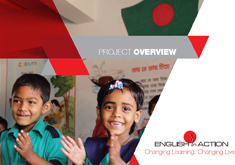The EIA programme includes a comprehensive research, monitoring and evaluation (RME) component which runs across the project’s activities. It plays a vital role in enabling EIA school component to measure the effectiveness and impact of the intervention.
Research results shows
Classroom practice of English teachers improved after 4 months and this was sustained a year later.
Key changes
• Substantial and sustained increase in teachers’ spoken English:
• 71% of primary teachers’ classroom talk was in English (72% after 12 months).
• 86% of secondary teachers’ classroom talk was in English (79% after 16 months).
• Substantial and sustained increase in student talk
• Primary students were talking for 27% of the lesson; teachers were talking for a third.
• Secondary students were talking for 23% of the lesson; teachers were talking for a third.
After 12 months of EIA, there were improvements in English language competency for students and teachers. In particular:
Students
• 50% of primary students achieved Grade 1 or above, compared to 35% before EIA.
• 90% of secondary students achieved Grade 1 or above, compared to 75% before EIA.
Teachers
• Shift to scoring higher grades (3-7) (from lower grades (0-2) before EIA.
Attitudes/perceptions
After 4-6 months of EIA:
Teachers
• Teachers were positive about EIA activities and learning English.
• Over 80% said they mostly used English in the classroom.
• Over 90% said they designed activities to enable interaction and students liked these.
• Almost all reported that EIA had helped improve their own English.
Students
• There had been success in creating positive student views to EIA activities.
• They liked the activities which promoted opportunities for them to talk and listen to audio.
• They expressed positive views to all EIA methods and materials used by teachers.
Over 80% said that speaking English is essential to learn English.






